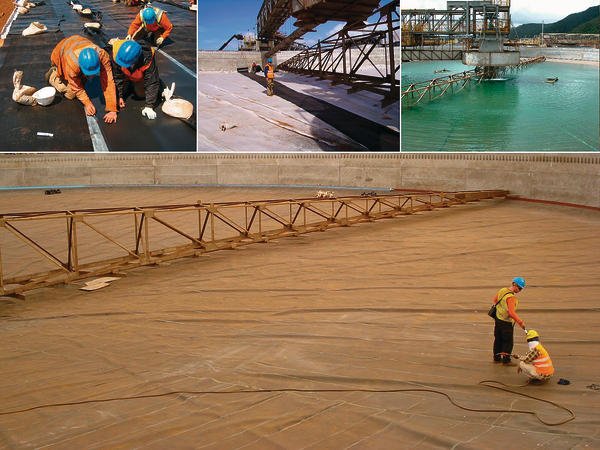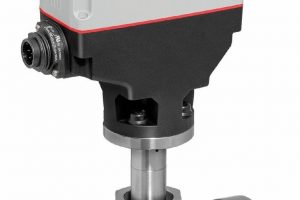In hydrometallurgical plants, ore concentrates are subjected to heat treatment and, if necessary, an ensuing separation process utilising sulphuric acid. In the course of this leaching process, the sulphuric acid solution is fed through sedimentation basins, in which any metallic salts present are separated from unusable solid tailings. With their diameter of 70 m, the six sedimentation basins from Goro Nickel in New Caledonia have huge dimensions, however – something that complicated the construction and layout of the soft rubber linings.
Frank Anhamm
The solution containing the metal salts is run off using a spill-over technique, while the solid sediments are transported to the centre of the sedimentation basin by a raking unit for removal. The sediments are fed through a total of four or six basins and washed in a back current to get rid of as much metallic salt as possible. The solution in the sedimentation basins has a pH of 1 to 2 at a temperature of up to +90 °C and is highly corrosive. Unprotected carbon steels would corrode and fail in a very short time. In addition, the high content of solids in the sedimentation basins causes wear, which can be effectively combated through the use of soft rubber linings.
The Goro Nickel nickel extraction plant in New Caledonia has huge dimensions, however. A total of six sedimentation basins are used in the plant, each 70 meters in diameter. Normal sedimentation basins with a diameter of up to 50 m are constructed on a steel support assembly and have a steel base, but this base was dispensed with for the Goro Nickel giants. Instead, they have only stainless steel walls mounted on a ring-shaped foundation. The compacted earth is protected by a thick membrane against penetration by the solution. For the Goro Nickel project, a Chemoline Geo-Membrane was installed together with a leak monitoring system.
Chemoline 4G is a 4 mm thick, pre-vulcanised lining that is based on highly chemical-resistant bromobutyl rubber. Soft rubber linings are normally applied to a shot-peened steel surface using an adhesive system or to a concrete surface that has been sandblasted and prepared with a conductive epoxy resin substrate. The rubber lining strips are applied without air pocket inclusions in sections about one metre broad and five metres long. After application, the rubber linings and the seams are checked for freedom from porosity by means of a high-voltage test. One pole of the test unit is connected to the steel structure or the applied conductive substrate. A test broom is then used to check 100 % of the surface, failure points being indicated by means of arcing.
Since the rubber lining for the Goro Nickel project was applied without bonding it to the substrate and therefore had no direct contact to a conducting opposite pole, Rema Tip Top had to delve into its box of tricks. Normally, the undersides of the standard linings are coated with an easy-bonding, chloroprene-based undercoating, permitting very good adhesion. To allow the Chemoline 4G to be tested, the standard CN layer was replaced with a conductive variant. This conductive rubber layer, around 0.8 mm thick, takes over the function of the conductive steel substrate nor-mally present, and facilitates high-voltage testing for porosity after application.
After solving the problem of the testing requirement, the sizes of the rubber linings for such gigantic dimensions were established. The greater the number of seams the lining has, the greater the chance of building in failure points. To take this into account, the dimensions of the lining strips were made unusually large. Thanks to an ultra-modern extruder in the Poing factory, it was possible to manufacture the linings with a width of 1.45 m and a length of 30 m. The rubber rolls, each weighing around 230 kg, could therefore be laid as one length from the basin sidewall to the exit cone, without any further transverse seams.
Difficulties on site
Reliable treatment on site in New Caledonia posed further challenges for the application company, since the weather conditions are generally very extreme. In the summer months, temperatures can dry the adhesive out faster than it can be applied if exposed to direct sunlight. In the rainy season, the heavy rainfall causes application problems due to humidity. To eliminate both of these drawbacks, the company built a tent roof that was easy to set up and take down and gave the necessary weather protection in the application area.
Hall 3.0, Booth B29
Online-Info www.cpp-net.com/2209403
Share:







